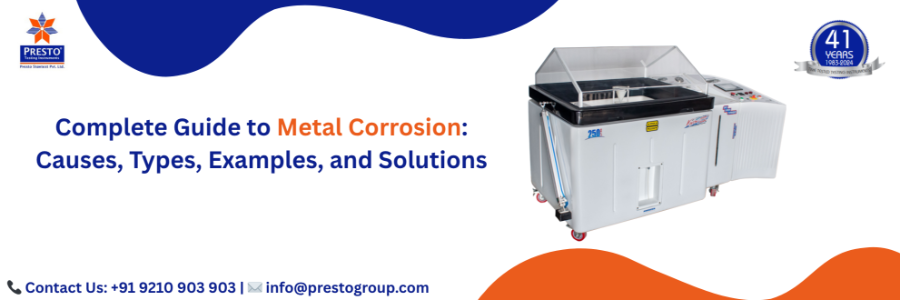

Corrosion of metals is something every industry faces at some point. From pipelines to packaging – when metals degrade– the results can be costly. That is where corrosion testers come into the picture. These machine help companies test how their materials will react to different environments and prevent damage before it is too late.
In this blog: we will walk you through what metal corrosion is, what causes it, the types of corrosion, and how modern corrosion testing equipment (like the Salt Spray Chamber) plays a big role in fighting back.
Corrosion is when metal starts to break down because of chemical reactions with its surrounding environment—usually air, moisture, or other chemicals.
Iron reacts with water and oxygen to form iron oxide, commonly known as rust. This rust slowly eats away at the metal, making it weaker and unsafe over time.
Corrosion isn’t just about looks (though rusted surfaces don’t look great). It’s about functionality, safety, and money. Here’s what makes it such a big concern:
Here’s a simple table explaining the types of corrosion you’re most likely to encounter:
| Type | What Happens |
| Uniform Corrosion | The entire surface wears out gradually over time |
| Galvanic Corrosion | Two dissimilar metals in contact degrade in salty moisture |
| Pitting Corrosion | Tiny holes form in specific spots |
| Crevice Corrosion | Occurs in tight spaces with trapped moisture |
| Intergranular Corrosion | Impacts the grain boundaries in metals |
| Stress Corrosion Cracking | Cracks appear due to a combo of stress and corrosion |
Corrosion has many triggers, both external and internal.
A corrosion tester is a specialized machine used in R&D labs, QA departments, and factories. It mimics harsh conditions like salty air, humidity, or high temperatures to see how well metals and coatings perform over time.

One of the most trusted corrosion tests is the salt spray test. Performed inside a Salt Spray Chamber, it exposes materials to a continuous fog of salty mist to speed up corrosion.
Presto's Salt Spray Chamber is widely trusted for this very reason. It gives consistent, reliable results that industries count on.
Not all corrosion testers are made equal. Here's what you should check:
A packaging company noticed foil seals rusting before their products reached consumers. Using a Salt Spray Chamber, they discovered a flaw in the coating application. After fixing it, shelf life increased by 35% and complaints dropped by 50%.
| Corrosion Type | Appearance | Cause | Industries |
| Uniform Corrosion | Even surface rust | General moisture exposure | Construction, Automotive |
| Galvanic Corrosion | Local damage | Contact between dissimilar metals | Plumbing, Marine |
| Pitting Corrosion | Small holes | Localized stagnant moisture | Oil, Petrochemical |
| Crevice Corrosion | Hidden rust in gaps | Fluid trapped in joints | Aerospace, Packaging |
Presto's Salt Spray Chamber is considered India’s most reliable corrosion testing solution. It’s known for:
Top manufacturers across auto, paint, packaging, and metals trust Presto to deliver accurate corrosion data that guides real product improvement.
1: What does a corrosion tester actually do?
Ans: It simulates moisture, salt, or heat exposure to test how metals or coatings behave over time.
2: Why is the salt spray test important?
Ans: It helps industries predict how long a product or coating can last in harsh conditions like coastal or industrial areas.
3: Who needs corrosion testing?
Ans: Industries like automotive, aerospace, electronics, packaging, and even construction all rely on it for safety and durability.
4: How long does a salt spray test take?
Ans: It varies! Some tests go for 24 hours; others continue for 1000+ hours, depending on the product’s use case.
5: What are common corrosion examples?
Ans: Rusted gates, battery leakage, green copper stains on pipes, silver tarnish—these are all signs of metal corrosion in daily life.
6: Can corrosion be good in any way?
Ans: Rarely, yes! Like the protective oxide layer on aluminum or biodegradable metals used in medical implants.
Whether you are in automotive, electronics, packaging, corrosion testing is something you just can not skip. It gives you the power to predict, prevent, and protect.
With trusted machines like the Presto Salt Spray Chamber, you can test confidently, develop durable products, and save time, money, and your reputation.
Looking for the right Salt Spray Chamber at the best price?
Call Us: +91 9210 903 903
Email: info@prestogroup.com
Our corrosion experts will help you pick a tester that meets your industry standards., budget, and testing goals.
Connect with us for your business enquiries. Generally, we respond within one or two working days.